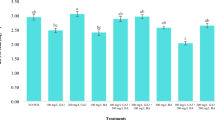Abstract
IT was stated in an earlier communication1 that if 4-mm. portions of the broad bean radicle were assayed for vitamin C, the ninth portion from the tip contained an average of 112.96 mgm. of the vitamin per 100 gm. of fresh weight. This amount was thought to be present within the region of maximum growth. Following this statement, J. Read pointed out to us in a private communication that the accepted region of maximum growth occurs at a distance of 5–7 mm. from the tip. He suggested that analysis of one-millimetre portions should therefore be undertaken.
This is a preview of subscription content, access via your institution
Access options
Subscribe to this journal
Receive 51 print issues and online access
$199.00 per year
only $3.90 per issue
Buy this article
- Purchase on Springer Link
- Instant access to full article PDF
Prices may be subject to local taxes which are calculated during checkout
Similar content being viewed by others
References
Shaw, A. C., and Pascoe, L. C., Nature, 164, 624 (1949).
Author information
Authors and Affiliations
Rights and permissions
About this article
Cite this article
SHAW, A., TATCHELL, R. Distribution of Vitamin C in the Tip of the Broad Bean Radicle. Nature 167, 116–117 (1951). https://doi.org/10.1038/167116a0
Issue Date:
DOI: https://doi.org/10.1038/167116a0
Comments
By submitting a comment you agree to abide by our Terms and Community Guidelines. If you find something abusive or that does not comply with our terms or guidelines please flag it as inappropriate.



